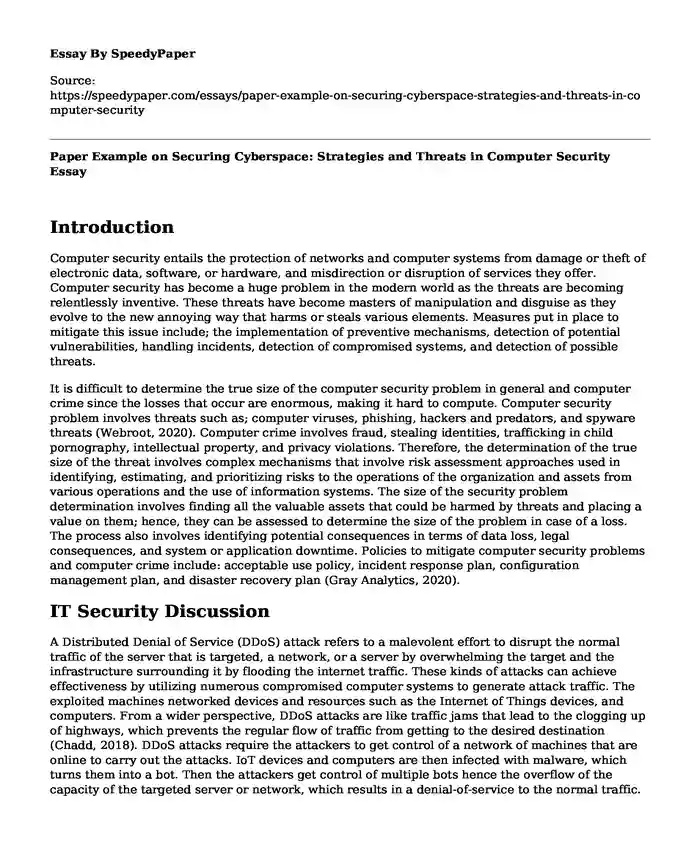
| Type of paper: | Essay |
| Categories: | Computer science Cyber security |
| Pages: | 3 |
| Wordcount: | 669 words |
Introduction
Computer security entails the protection of networks and computer systems from damage or theft of electronic data, software, or hardware, and misdirection or disruption of services they offer. Computer security has become a huge problem in the modern world as the threats are becoming relentlessly inventive. These threats have become masters of manipulation and disguise as they evolve to the new annoying way that harms or steals various elements. Measures put in place to mitigate this issue include; the implementation of preventive mechanisms, detection of potential vulnerabilities, handling incidents, detection of compromised systems, and detection of possible threats.
It is difficult to determine the true size of the computer security problem in general and computer crime since the losses that occur are enormous, making it hard to compute. Computer security problem involves threats such as; computer viruses, phishing, hackers and predators, and spyware threats (Webroot, 2020). Computer crime involves fraud, stealing identities, trafficking in child pornography, intellectual property, and privacy violations. Therefore, the determination of the true size of the threat involves complex mechanisms that involve risk assessment approaches used in identifying, estimating, and prioritizing risks to the operations of the organization and assets from various operations and the use of information systems. The size of the security problem determination involves finding all the valuable assets that could be harmed by threats and placing a value on them; hence, they can be assessed to determine the size of the problem in case of a loss. The process also involves identifying potential consequences in terms of data loss, legal consequences, and system or application downtime. Policies to mitigate computer security problems and computer crime include: acceptable use policy, incident response plan, configuration management plan, and disaster recovery plan (Gray Analytics, 2020).
IT Security Discussion
A Distributed Denial of Service (DDoS) attack refers to a malevolent effort to disrupt the normal traffic of the server that is targeted, a network, or a server by overwhelming the target and the infrastructure surrounding it by flooding the internet traffic. These kinds of attacks can achieve effectiveness by utilizing numerous compromised computer systems to generate attack traffic. The exploited machines networked devices and resources such as the Internet of Things devices, and computers. From a wider perspective, DDoS attacks are like traffic jams that lead to the clogging up of highways, which prevents the regular flow of traffic from getting to the desired destination (Chadd, 2018). DDoS attacks require the attackers to get control of a network of machines that are online to carry out the attacks. IoT devices and computers are then infected with malware, which turns them into a bot. Then the attackers get control of multiple bots hence the overflow of the capacity of the targeted server or network, which results in a denial-of-service to the normal traffic.
Well, a known enterprise like GitHub has not been spared by DDoS attacks. Therefore, the enterprise needs to protect itself from a DDoS attack through various security strategies. GitHub needs to quickly recognize the signs of a DDoS attack as a precaution is the best defense mechanism for this kind of attack. The enterprise should also use a DDoS DDoS-protected VPN, which will help in the filtration of the incoming traffic and serve as an anti-DDoS mitigation server. The enterprise should have its threat Intel ready and contact its ISP provider in case of a suspicion of a DDoS attack.
Ramifications to a company attacked by a DDoS include Reduced turnover, loss of productivity of the targeted server or internet such as an online portal, damage to the reputation of a brand that has suffered the attack, and loss of confidential data.
References
Chadd, A. (2018). DDoS attacks: past, present and future. Network Security, 2018(7), 13-15. https://www.sciencedirect.com/science/article/abs/pii/S1353485818300692
Gray Analytics, (2020). Policies for computer security problems and computer crime. https://www.grayanalytics.com/uncategorized/the-4-most-important-cyber-security-policies-for-businesses/
Webroot, (2020). Types of computer security threats and how to avoid them. Open text Company. https://www.webroot.com/us/en/resources/tips-articles/computer-security-threats
Cite this page
Paper Example on Securing Cyberspace: Strategies and Threats in Computer Security. (2023, Nov 06). Retrieved from https://speedypaper.com/essays/paper-example-on-securing-cyberspace-strategies-and-threats-in-computer-security
Request Removal
If you are the original author of this essay and no longer wish to have it published on the SpeedyPaper website, please click below to request its removal:
- Free Essay Example on Internet of Things
- Cell Phone Evolution - Essay Example on Technology
- Free Essay - The FBI Victorious With Transnational Challenges to Catch Cybercriminals
- Free Essay. Evaluation of a New Master Program (Communication and Culture)
- Paper Example. Safe Harbor Agreement
- Paper Example. Piloting Digital Devices
- Cybercrime: The Growing Threat and Strategies for Adaptation - Essay Sample
Popular categories




